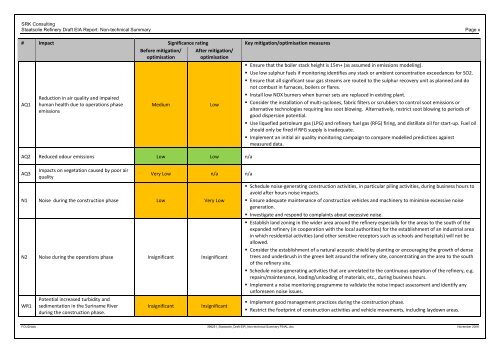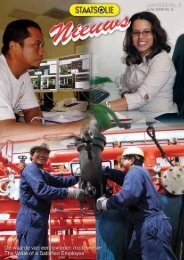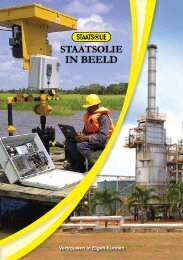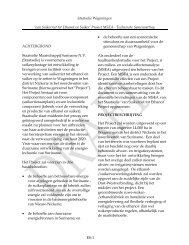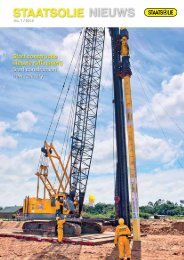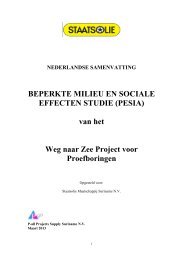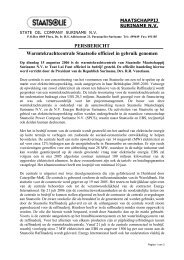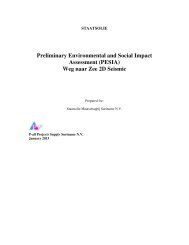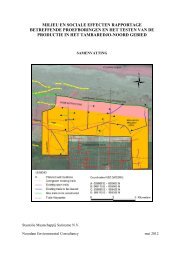English - Staatsolie
English - Staatsolie
English - Staatsolie
You also want an ePaper? Increase the reach of your titles
YUMPU automatically turns print PDFs into web optimized ePapers that Google loves.
SRK Consulting<br />
<strong>Staatsolie</strong> Refinery Draft EIA Report: Non-technical Summary Page x<br />
# Impact Significance rating Key mitigation/optimisation measures<br />
AQ1<br />
Reduction in air quality and impaired<br />
human health due to operations phase<br />
emissions<br />
Before mitigation/<br />
optimisation<br />
After mitigation/<br />
optimisation<br />
Medium Low<br />
AQ2 Reduced odour emissions Low Low n/a<br />
AQ3<br />
Impacts on vegetation caused by poor air<br />
quality<br />
Very Low n/a n/a<br />
N1 Noise during the construction phase Low Very Low<br />
N2 Noise during the operations phase Insignificant Insignificant<br />
WR1<br />
Potential increased turbidity and<br />
sedimentation in the Suriname River<br />
during the construction phase.<br />
Insignificant Insignificant<br />
Ensure that the boiler stack height is 15m+ (as assumed in emissions modeling).<br />
Use low sulphur fuels if monitoring identifies any stack or ambient concentration exceedances for SO2.<br />
Ensure that all significant sour gas streams are routed to the sulphur recovery unit as planned and do<br />
not combust in furnaces, boilers or flares.<br />
Install low NOX burners when burner sets are replaced in existing plant.<br />
Consider the installation of multi-cyclones, fabric filters or scrubbers to control soot emissions or<br />
alternative technologies requiring less soot blowing. Alternatively, restrict soot blowing to periods of<br />
good dispersion potential.<br />
Use liquefied petroleum gas (LPG) and refinery fuel gas (RFG) firing, and distillate oil for start-up. Fuel oil<br />
should only be fired if RFG supply is inadequate.<br />
Implement an initial air quality monitoring campaign to compare modelled predictions against<br />
measured data.<br />
Schedule noise-generating construction activities, in particular piling activities, during business hours to<br />
avoid after hours noise impacts.<br />
Ensure adequate maintenance of construction vehicles and machinery to minimise excessive noise<br />
generation.<br />
Investigate and respond to complaints about excessive noise.<br />
Establish land zoning in the wider area around the refinery especially for the areas to the south of the<br />
expanded refinery (in cooperation with the local authorities) for the establishment of an industrial area<br />
in which residential activities (and other sensitive receptors such as schools and hospitals) will not be<br />
allowed.<br />
Consider the establishment of a natural acoustic shield by planting or encouraging the growth of dense<br />
trees and underbrush in the green belt around the refinery site, concentrating on the area to the south<br />
of the refinery site.<br />
Schedule noise-generating activities that are unrelated to the continuous operation of the refinery, e.g.<br />
repairs/maintenance, loading/unloading of materials, etc., during business hours.<br />
Implement a noise monitoring programme to validate the noise impact assessment and identify any<br />
unforeseen noise issues.<br />
Implement good management practices during the construction phase.<br />
Restrict the footprint of construction activities and vehicle movements, including laydown areas.<br />
FOUD/dalc 398251_<strong>Staatsolie</strong>_Draft EIR_Non-technical Summary FINAL.doc November 2009


